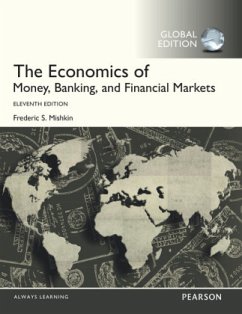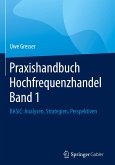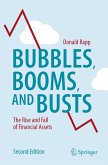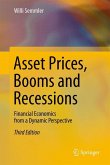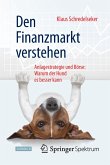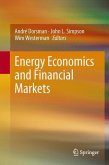For courses in Money and Banking or General Economics.
An Analytical Framework for Understanding Financial Markets
The Economics of Money, Banking and Financial Markets brings a fresh perspective to today’s major questions surrounding financial policy. Influenced by his term as Governor of the Federal Reserve, Frederic Mishkin offers students a unique viewpoint and informed insight into the monetary policy process, the regulation and supervision of the financial system, and the internationalization of financial markets.
Continuing to set the standard for money and banking courses, the Eleventh Edition provides a unifying, analytic framework for learning that fits a wide variety of syllabi. Core economic principles organize students' thinking, while current real-world examples keep them engaged and motivated.
MyEconLab® is not included. Students, if MyEconLab is a recommended/mandatory component of the course, please ask your instructor for the correct ISBN and course ID. MyEconLab should only be purchased when required by an instructor. Instructors, contact your Pearson representative for more information.
MyEconLab is an online homework, tutorial, and assessment product designed to personalize learning and improve results. With a wide range of interactive, engaging, and assignable activities, students are encouraged to actively learn and retain tough course concepts.
Features + Benefits
This title is a Pearson Global Edition. The Editorial team at Pearson has worked closely with educators around the world to include content, which is especially relevant to students outside the United States.
Keep Students Focused and Motivated
A unifying, analytic framework uses a few basic economic principles to organize students’ thinking about the structure of financial markets, the foreign exchange markets, financial institution management, and the role of monetary policy in the economy.
A careful, step-by-step development of models (an approach found in the best principles of economics textbooks) makes it easier for students to learn.
An international perspective is completely integrated throughout the text.
A thoroughly up-to-date treatment of the latest developments in monetary theory is included.
A special feature called “Following the Financial News” encourages reading of a financial newspaper
An applications-oriented perspective with numerous applications and special-topic boxes increases students’ interest by showing them how to apply theory to real-world exampleshe enhanced e-text.
NEW! Real-time data analysis. Problems marked with the RTDA logo require that students download data from the Federal Reserve Bank of St. Louis FRED website, and then use the data to answer questions about current issues in macroeconomics.
Offers a no-fuss solution for instructors who want to make the most recent data a central part of their macroeconomics course. Real-time data analysis exercises will not only help students to understand macroeconomics better, but will enable them to see the real world relevance of their study of macroeconomics.
Up-to-Date Information
NEW! Will Bitcoin will become the money of the future (Chapter 3)
NEW! The effects of the Obama tax increase on bond interest rates (Chapter 6)
REVISED! The evolution of the Fed’s communication strategy (Chapter 13)
NEW! The movement along the MP curve when the Fed raised the federal funds target from 2004 to 2006 (Chapter 21)
NEW! FYI box on what the word “autonomous” means (Chapter 22)
NEW! Nominal GDP targeting (Chapter 23)
NEW! Reorganized Part 3, Financial Institutions. Updates include an FYI box on the tyranny of collateral (Chapter 8), more detail on securitization and the shadow banking system (Chapter 11), and the response of financial regulation to the global financial crisis (Chapter 12).
NEW! The Euro Crisis. Includes information on the European sovereign debt crisis (Chapter 12), monetary unions (Chapter 18), and whether the Euro will survive (Chapter 18).
NEW! Non-Conventional Monetary Policy and the Zero Lower Bound. Includes a new section on quantitative easing and the money supply, 2007-2014 (Chapter 14) and forward guidance and the commitment to future policy actions (Chapter 15). Chapter 23 has also been significantly revised to include monetary policy at the zero lower bound, unconventional monetary policy, and the effects of Abenomics on Japanese monetary policy in 2013.
Flexibility and Modularity
Core chapters provide the basic analysis used throughout the book, and other chapters or sections of chapters can be used or omitted according to instructor preferences.
The text also allows instructors to cover the most important issues in monetary theory without having to do a detailed development of the IS, MP, and AD curves in Chapters 20 and 21. Instructors who want to teach a more complete treatment of monetary theory would make use of these chapters.
Part 6 on monetary theory can easily be taught before Part 4 of the book in order to give students a deeper understanding of the rationale for monetary policy.
Chapter 25 on the transmission mechanisms of monetary policy can be taught at many different points in the course—either with Part 4 of the book when monetary policy is discussed or with Chapter 20 or Chapter 22 when the concept of aggregate demand is developed. It could also be taught at the end of the book as a special topic.
The internationalization of the text through marked international sections within chapters, as well as through complete separate chapters on the foreign exchange market and the international monetary system, is comprehensive yet flexible. The international sections within chapters are self-contained and can be omitted with little loss of continuity.
To illustrate how this book can be used for courses with varying emphases, several course outlines are suggested for a semester teaching schedule. More detailed information about how the text can be used flexibly in your course is available in the Instructor’s Manual.
MyEconLab® is not included. Students, if MyEconLab is a recommended/mandatory component of the course, please ask your instructor for the correct ISBN. MyEconLab should only be purchased when required by an instructor. Instructors, contact your Pearson representative for more information.
Personalize learning with MyEconLab
Enhanced e-Text with mini-lecture videos provide a new way of learning. Combining resources that illuminate content with accessible self-assessment, MyEconLab with Enhanced eText provides students with a complete digital learning experience—all in one place.
Students can watch over 120 mini-lecture videos presented by the author for every figure in the text.
Mini-Lecture Videos of all the data and analytic figures in the text, which can be used in class or viewed by the students on their own to provide them with a step-by-step analysis of the graphs.
The Enhanced Pearson eText available within the online course materials and offline via an iPad app.
Digital Interactives The new Digital Interactives in Pearson’s MyEconLab are poised to change how students learn core economic concepts. Organized in progressive levels, each focusing on a core learning outcome, Digital Interactives immerse students in a fundamental economic principle, helping them to learn actively. They can be presented in class as visually stimulating, highly engaging lecture tools, and can also be assigned with assessment questions for grading. Digital Interactives are designed for use in traditional, online, and hybrid courses, and many incorporate real-time data, as well as data display and analysis tools.
Learning Catalyics: Generate class discussion, guide your lecture, and promote peer-to-peer learning with real-time analytics. MyLab & Mastering with eText now provides Learning Catalytics–an interactive student engagement tool that uses students’ smartphones, tablets, or laptops to engage them in more sophisticated tasks and thinking.
Real-Time Data Analysis Exercises allow instructors to assign problems which use up-to-the-minute data. Each RTDA exercise loads the appropriate and most current available data from FRED, a comprehensive and up-to-date data set maintained by the Federal Reserve Bank of St. Louis. Exercises are graded based on that instance of data, and feedback is provided.
End-of-chapter questions and applied problems from the text are available in MyEconLab.
Applications from the text are also available with assignable questions.
Personal Study Plans are created for each individual student based on their PART 1. INTRODUCTION
1. Why Study Money, Banking, and Financial Markets?
2. An Overview of the Financial System
3. What Is Money?
PART 2. FINANCIAL MARKETS
4. Understanding Interest Rates
5. The Behavior of Interest Rates
6. The Risk and Term Structure of Interest Rates
7. The Stock Market, the Theory of Rational Expectations, and the Efficient Market Hypothesis
PART 3. FINANCIAL INSTITUTIONS
8. An Economic Analysis of Financial Structure
9. Banking and the Management of Financial Institutions
10. Economic Analysis of Financial Regulation
11. Banking Industry: Structure and Competition
12. Financial Crises
PART 4. CENTRAL BANKING AND THE CONDUCT OF MONETARY POLICY
13. Central Banks and the Federal Reserve System
14. The Money Supply Process
15. The Tools of Monetary Policy
16. The Conduct of Monetary Policy: Strategy and Tactics
PART 5. INTERNATIONAL FINANCE AND MONETARY POLICY
17. The Foreign Exchange Market
18. The International Financial System
PART 6. MONETARY THEORY
19. Quantity Theory, Inflation, and the Demand for Money
20. The IS Curve
21. The Monetary Policy and Aggregate Demand Curves
22. Aggregate Demand and Supply Analysis
23. Monetary Policy Theory
24. The Role of Expectations in Monetary Policy
25. Transmission Mechanisms of Monetary Policy
CHAPTERS ON THE WEB
26. Financial Crjses in Emerging Market Economies
27. The ISLM Model
28. Nonbank Finance
29. Financial Derivatives
30. Conflicts of Interest in the Financial Services Industry
For courses in Money and Banking or General Economics.
An Analytical Framework for Understanding Financial Markets
The Economics of Money, Banking and Financial Markets brings a fresh perspective to today's major questions surrounding financial policy. Influenced by his term as Governor of the Federal Reserve, Frederic Mishkin offers students a unique viewpoint and informed insight into the monetary policy process, the regulation and supervision of the financial system, and the internationalization of financial markets.
Continuing to set the standard for money and banking courses, the Eleventh Edition provides a unifying, analytic framework for learning that fits a wide variety of syllabi. Core economic principles organize students' thinking, while current real-world examples keep them engaged and motivated.
MyEconLab is an online homework, tutorial, and assessment product designed to personalize learning and improve results. With a wide range of interactive, engaging, and assignable activities, students are encouraged to actively learn and retain tough course concepts.
Please note that the product you are purchasing does not include MyEconLab.
MyEconLab
Join over 11 million students benefiting from Pearson MyLabs.
This title can be supported by MyEconLab, an online homework and tutorial system designed to test and build your understanding. Would you like to use the power of MyEconLab to accelerate your learning? You need both an access card and a course ID to access MyEconLab.
These are the steps you need to take:
1. Make sure that your lecturer is already using the system
Ask your lecturer before purchasing a MyLab product as you will need a course ID from them before you can gain access to the system.
2. Check whether an access card has been included with the book at a reduced cost
If it has, it will be on the inside back cover of the book.
3. If you have a course ID but no access code, you can benefit from MyEconLab at a reduced price by purchasing a pack containing a copy of the book and an access code for MyEconLab (ISBN:9781292094304)
4. If your lecturer is using the MyLab and you would like to purchase the product...
Go to www.myeconlab.com to buy access to this interactive study programme.
For educator access, contact your Pearson representative. To find out who your Pearson representative is, visit www.pearsoned.co.uk/replocator
An Analytical Framework for Understanding Financial Markets
The Economics of Money, Banking and Financial Markets brings a fresh perspective to today’s major questions surrounding financial policy. Influenced by his term as Governor of the Federal Reserve, Frederic Mishkin offers students a unique viewpoint and informed insight into the monetary policy process, the regulation and supervision of the financial system, and the internationalization of financial markets.
Continuing to set the standard for money and banking courses, the Eleventh Edition provides a unifying, analytic framework for learning that fits a wide variety of syllabi. Core economic principles organize students' thinking, while current real-world examples keep them engaged and motivated.
MyEconLab® is not included. Students, if MyEconLab is a recommended/mandatory component of the course, please ask your instructor for the correct ISBN and course ID. MyEconLab should only be purchased when required by an instructor. Instructors, contact your Pearson representative for more information.
MyEconLab is an online homework, tutorial, and assessment product designed to personalize learning and improve results. With a wide range of interactive, engaging, and assignable activities, students are encouraged to actively learn and retain tough course concepts.
Features + Benefits
This title is a Pearson Global Edition. The Editorial team at Pearson has worked closely with educators around the world to include content, which is especially relevant to students outside the United States.
Keep Students Focused and Motivated
A unifying, analytic framework uses a few basic economic principles to organize students’ thinking about the structure of financial markets, the foreign exchange markets, financial institution management, and the role of monetary policy in the economy.
A careful, step-by-step development of models (an approach found in the best principles of economics textbooks) makes it easier for students to learn.
An international perspective is completely integrated throughout the text.
A thoroughly up-to-date treatment of the latest developments in monetary theory is included.
A special feature called “Following the Financial News” encourages reading of a financial newspaper
An applications-oriented perspective with numerous applications and special-topic boxes increases students’ interest by showing them how to apply theory to real-world exampleshe enhanced e-text.
NEW! Real-time data analysis. Problems marked with the RTDA logo require that students download data from the Federal Reserve Bank of St. Louis FRED website, and then use the data to answer questions about current issues in macroeconomics.
Offers a no-fuss solution for instructors who want to make the most recent data a central part of their macroeconomics course. Real-time data analysis exercises will not only help students to understand macroeconomics better, but will enable them to see the real world relevance of their study of macroeconomics.
Up-to-Date Information
NEW! Will Bitcoin will become the money of the future (Chapter 3)
NEW! The effects of the Obama tax increase on bond interest rates (Chapter 6)
REVISED! The evolution of the Fed’s communication strategy (Chapter 13)
NEW! The movement along the MP curve when the Fed raised the federal funds target from 2004 to 2006 (Chapter 21)
NEW! FYI box on what the word “autonomous” means (Chapter 22)
NEW! Nominal GDP targeting (Chapter 23)
NEW! Reorganized Part 3, Financial Institutions. Updates include an FYI box on the tyranny of collateral (Chapter 8), more detail on securitization and the shadow banking system (Chapter 11), and the response of financial regulation to the global financial crisis (Chapter 12).
NEW! The Euro Crisis. Includes information on the European sovereign debt crisis (Chapter 12), monetary unions (Chapter 18), and whether the Euro will survive (Chapter 18).
NEW! Non-Conventional Monetary Policy and the Zero Lower Bound. Includes a new section on quantitative easing and the money supply, 2007-2014 (Chapter 14) and forward guidance and the commitment to future policy actions (Chapter 15). Chapter 23 has also been significantly revised to include monetary policy at the zero lower bound, unconventional monetary policy, and the effects of Abenomics on Japanese monetary policy in 2013.
Flexibility and Modularity
Core chapters provide the basic analysis used throughout the book, and other chapters or sections of chapters can be used or omitted according to instructor preferences.
The text also allows instructors to cover the most important issues in monetary theory without having to do a detailed development of the IS, MP, and AD curves in Chapters 20 and 21. Instructors who want to teach a more complete treatment of monetary theory would make use of these chapters.
Part 6 on monetary theory can easily be taught before Part 4 of the book in order to give students a deeper understanding of the rationale for monetary policy.
Chapter 25 on the transmission mechanisms of monetary policy can be taught at many different points in the course—either with Part 4 of the book when monetary policy is discussed or with Chapter 20 or Chapter 22 when the concept of aggregate demand is developed. It could also be taught at the end of the book as a special topic.
The internationalization of the text through marked international sections within chapters, as well as through complete separate chapters on the foreign exchange market and the international monetary system, is comprehensive yet flexible. The international sections within chapters are self-contained and can be omitted with little loss of continuity.
To illustrate how this book can be used for courses with varying emphases, several course outlines are suggested for a semester teaching schedule. More detailed information about how the text can be used flexibly in your course is available in the Instructor’s Manual.
MyEconLab® is not included. Students, if MyEconLab is a recommended/mandatory component of the course, please ask your instructor for the correct ISBN. MyEconLab should only be purchased when required by an instructor. Instructors, contact your Pearson representative for more information.
Personalize learning with MyEconLab
Enhanced e-Text with mini-lecture videos provide a new way of learning. Combining resources that illuminate content with accessible self-assessment, MyEconLab with Enhanced eText provides students with a complete digital learning experience—all in one place.
Students can watch over 120 mini-lecture videos presented by the author for every figure in the text.
Mini-Lecture Videos of all the data and analytic figures in the text, which can be used in class or viewed by the students on their own to provide them with a step-by-step analysis of the graphs.
The Enhanced Pearson eText available within the online course materials and offline via an iPad app.
Digital Interactives The new Digital Interactives in Pearson’s MyEconLab are poised to change how students learn core economic concepts. Organized in progressive levels, each focusing on a core learning outcome, Digital Interactives immerse students in a fundamental economic principle, helping them to learn actively. They can be presented in class as visually stimulating, highly engaging lecture tools, and can also be assigned with assessment questions for grading. Digital Interactives are designed for use in traditional, online, and hybrid courses, and many incorporate real-time data, as well as data display and analysis tools.
Learning Catalyics: Generate class discussion, guide your lecture, and promote peer-to-peer learning with real-time analytics. MyLab & Mastering with eText now provides Learning Catalytics–an interactive student engagement tool that uses students’ smartphones, tablets, or laptops to engage them in more sophisticated tasks and thinking.
Real-Time Data Analysis Exercises allow instructors to assign problems which use up-to-the-minute data. Each RTDA exercise loads the appropriate and most current available data from FRED, a comprehensive and up-to-date data set maintained by the Federal Reserve Bank of St. Louis. Exercises are graded based on that instance of data, and feedback is provided.
End-of-chapter questions and applied problems from the text are available in MyEconLab.
Applications from the text are also available with assignable questions.
Personal Study Plans are created for each individual student based on their PART 1. INTRODUCTION
1. Why Study Money, Banking, and Financial Markets?
2. An Overview of the Financial System
3. What Is Money?
PART 2. FINANCIAL MARKETS
4. Understanding Interest Rates
5. The Behavior of Interest Rates
6. The Risk and Term Structure of Interest Rates
7. The Stock Market, the Theory of Rational Expectations, and the Efficient Market Hypothesis
PART 3. FINANCIAL INSTITUTIONS
8. An Economic Analysis of Financial Structure
9. Banking and the Management of Financial Institutions
10. Economic Analysis of Financial Regulation
11. Banking Industry: Structure and Competition
12. Financial Crises
PART 4. CENTRAL BANKING AND THE CONDUCT OF MONETARY POLICY
13. Central Banks and the Federal Reserve System
14. The Money Supply Process
15. The Tools of Monetary Policy
16. The Conduct of Monetary Policy: Strategy and Tactics
PART 5. INTERNATIONAL FINANCE AND MONETARY POLICY
17. The Foreign Exchange Market
18. The International Financial System
PART 6. MONETARY THEORY
19. Quantity Theory, Inflation, and the Demand for Money
20. The IS Curve
21. The Monetary Policy and Aggregate Demand Curves
22. Aggregate Demand and Supply Analysis
23. Monetary Policy Theory
24. The Role of Expectations in Monetary Policy
25. Transmission Mechanisms of Monetary Policy
CHAPTERS ON THE WEB
26. Financial Crjses in Emerging Market Economies
27. The ISLM Model
28. Nonbank Finance
29. Financial Derivatives
30. Conflicts of Interest in the Financial Services Industry
For courses in Money and Banking or General Economics.
An Analytical Framework for Understanding Financial Markets
The Economics of Money, Banking and Financial Markets brings a fresh perspective to today's major questions surrounding financial policy. Influenced by his term as Governor of the Federal Reserve, Frederic Mishkin offers students a unique viewpoint and informed insight into the monetary policy process, the regulation and supervision of the financial system, and the internationalization of financial markets.
Continuing to set the standard for money and banking courses, the Eleventh Edition provides a unifying, analytic framework for learning that fits a wide variety of syllabi. Core economic principles organize students' thinking, while current real-world examples keep them engaged and motivated.
MyEconLab is an online homework, tutorial, and assessment product designed to personalize learning and improve results. With a wide range of interactive, engaging, and assignable activities, students are encouraged to actively learn and retain tough course concepts.
Please note that the product you are purchasing does not include MyEconLab.
MyEconLab
Join over 11 million students benefiting from Pearson MyLabs.
This title can be supported by MyEconLab, an online homework and tutorial system designed to test and build your understanding. Would you like to use the power of MyEconLab to accelerate your learning? You need both an access card and a course ID to access MyEconLab.
These are the steps you need to take:
1. Make sure that your lecturer is already using the system
Ask your lecturer before purchasing a MyLab product as you will need a course ID from them before you can gain access to the system.
2. Check whether an access card has been included with the book at a reduced cost
If it has, it will be on the inside back cover of the book.
3. If you have a course ID but no access code, you can benefit from MyEconLab at a reduced price by purchasing a pack containing a copy of the book and an access code for MyEconLab (ISBN:9781292094304)
4. If your lecturer is using the MyLab and you would like to purchase the product...
Go to www.myeconlab.com to buy access to this interactive study programme.
For educator access, contact your Pearson representative. To find out who your Pearson representative is, visit www.pearsoned.co.uk/replocator

